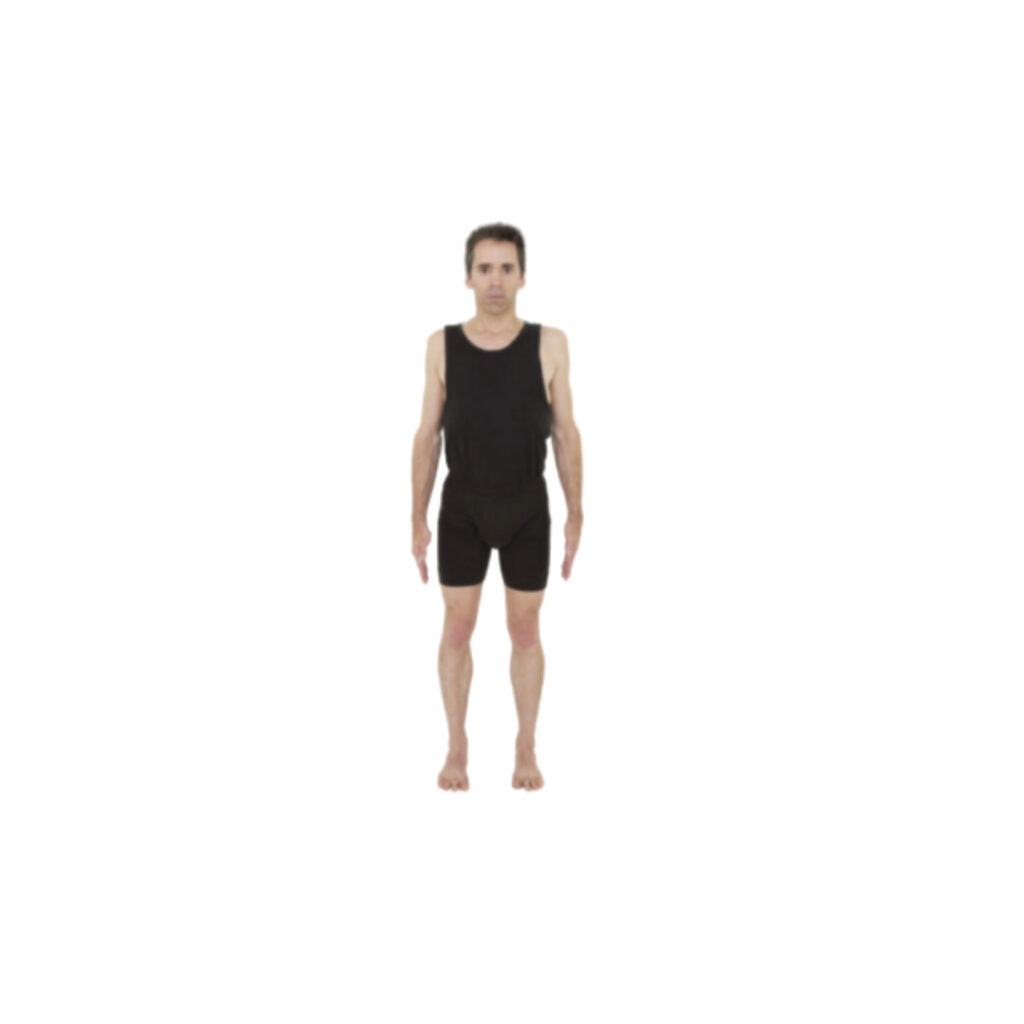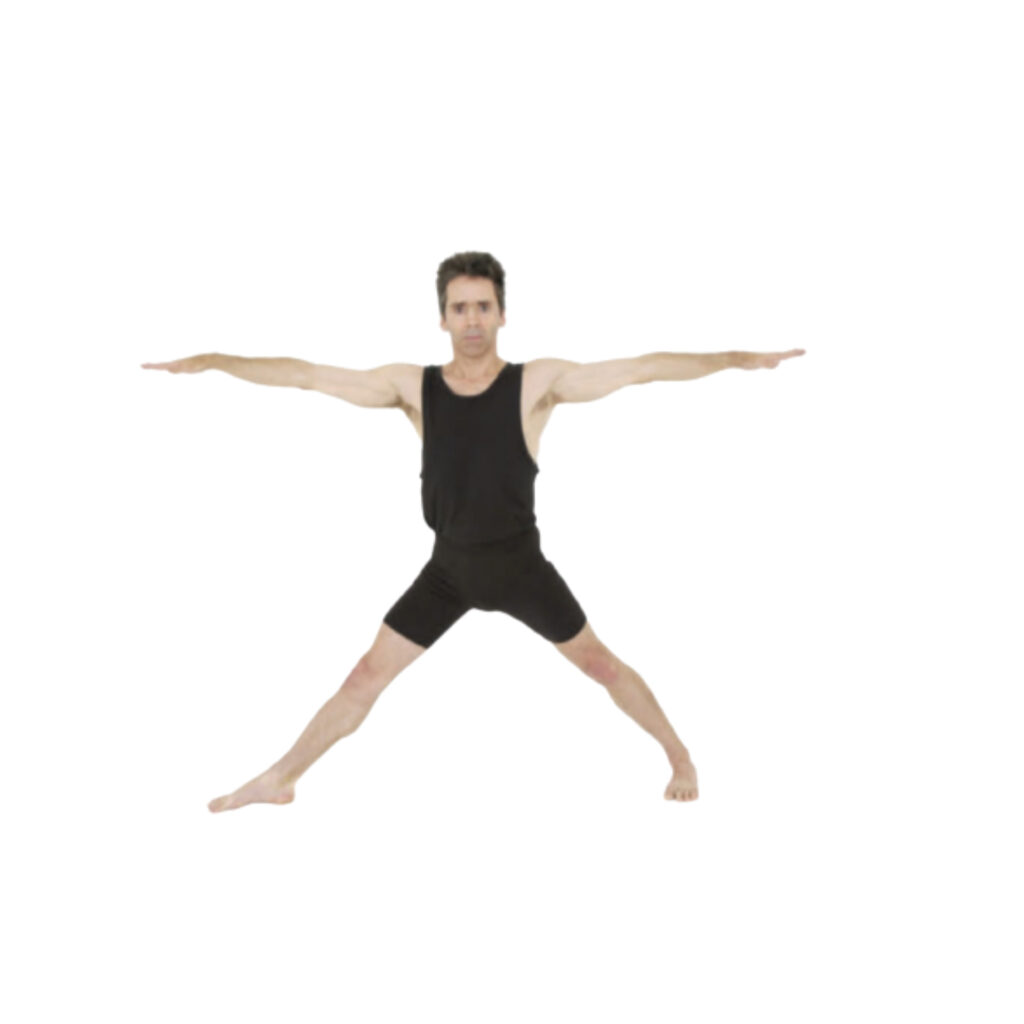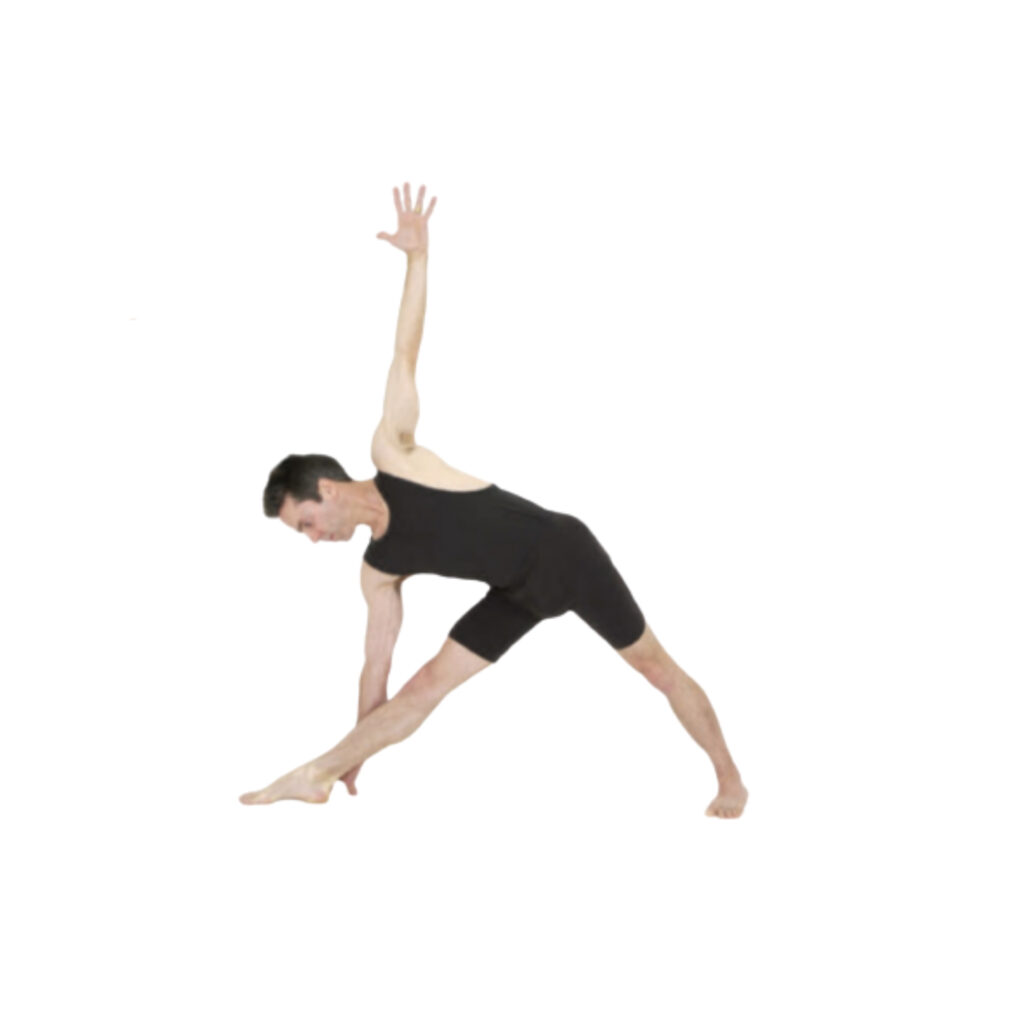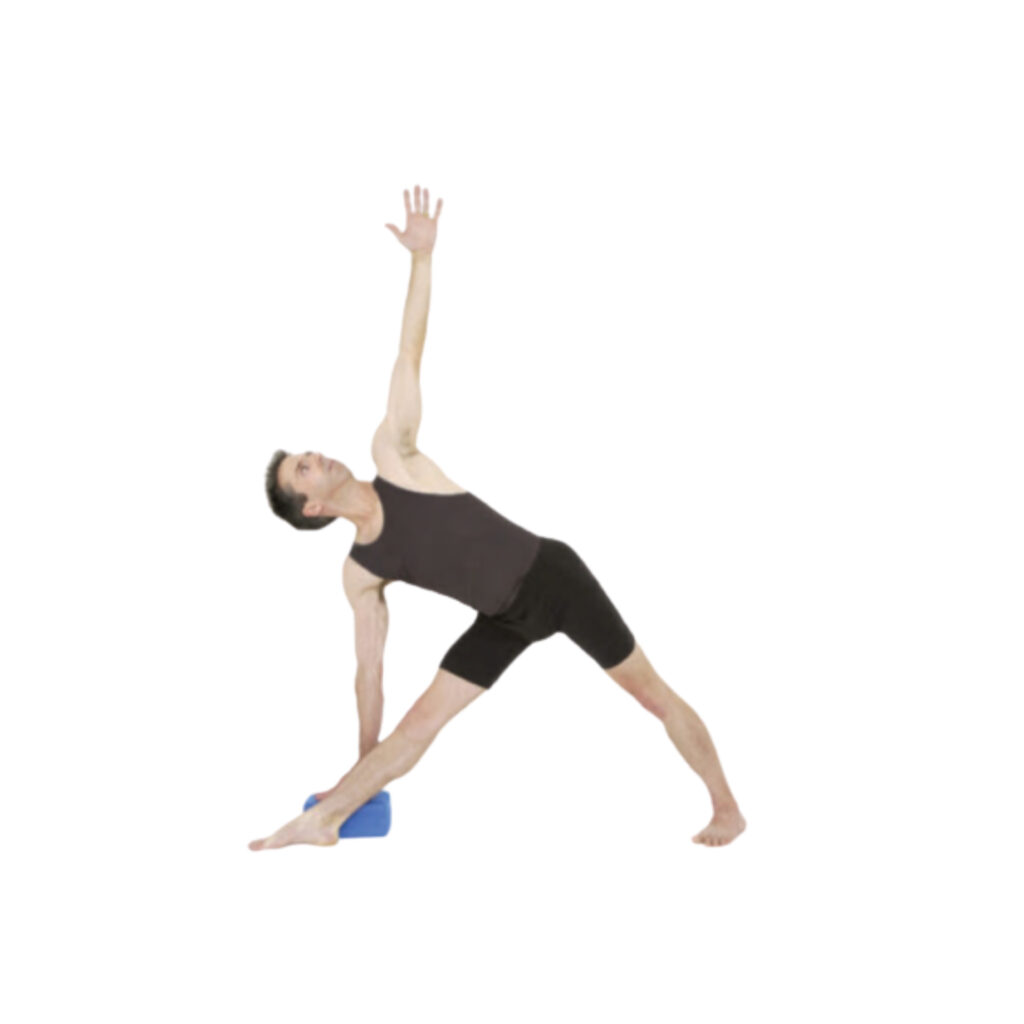Triangle Pose or Utthita Trikonasana is a powerful lateral bend that is useful for improving breathing ability, enhancing the mobility of the spine, symmetry of the body and improved motion in the shoulders and hips.
Meaning
The Trikonasana name comes from the Sanskrit words:
- tri meaning ‘three’,
- kona meaning ‘angle’,
- asana meaning ‘pose’
It refers to the triangular shape created by your body in the full version of the Extended Triangle Pose (Utthita Trikonasana). “Utthita” means “extended” in Sanskrit.
- Utthita: extended
- Trikona: triangle
- Asana: pose
Triangle Pose (Utthita Trikonasana) also reminds of the three guns (the three modes of material nature):
- sattva (which rises for Lord Vishnu the preserver): represents goodness and purity;
- rajas (which rises from Lord Brahma the creator): represents action and activity;
- tamas (which rises from Lord Shiva the destroyer): characterized by inertness or the destructive energy to recreate a new cycle
Three gunas color every aspect of our existence. The purpose of yoga practice is to increase sattva in our mind and rajas in our body. The physic is kept active and the mind is reflected. When the mind is fully charged with sattva (absolute purity), the mind becomes calm. This peace is necessary to see the true nature of oneself.
Information
| Known as: | Triangle Pose, Extended Triangle Pose, Trikonasana, Utthita Trikonasana |
| Sanskrit Name: | Trikonasana (त्रिकोणासन), Utthita Trikonasana (उत्थित त्रिकोणासन) |
| Pronounce: | oo-TEE-tah trik-cone-AHS-anna |
| English Name: | Triangle Pose, Extended Triangle Pose |
| IAST: | utthita trikoṇāsana |
| Level: | Beginner, Intermediate |
| Total time: | 30 to 60 seconds |
| Counterpose: | Standing Forward Bend (Uttanasana) |
| Type: | Stretch, Side bend |
| Drishti: | (1) Upward, (2) Forward, (3) Down |
| Stretch: | Calf, Hamstring, Knee, Hip, Thigh, Inguinal region, Vertebral column, Thorax |
| Strength: | Ankle, Thigh, Knee |
| Muscle Worked: | Core, hamstrings, thighs, calf |
| Chakra: | Anahata Chakra, Swadisthana Chakra, Muladhara Chakra |
| Contraindications: | Low blood pressure, Neck injury (do not look up), Congestive heart disorders |
| Regime Note: | Consult a doctor before starting Trikonasana regime |
Science Behind Triangle Pose or Utthita Trikonasana
There are two different dynamic energies associated with the Triangle Pose (Utthita Trikonasana):
- The first is extending the legs towards the Earth
- The econd is sending energy upward through your extended arms.
This asana is a perfect confluence of sthira and sukha, or effort and effortlessness. Through this, soft and hard, contraction and expansion, descending and ascending, and other contrasts like solar and lunar are also addressed in this asana.
While this asana feels like a turning point, when you reach the floor, you will feel that it is more about balance. But you will feel stable and comfortable if you know how to use your core and leg muscles to support yourself. When you get your alignment right, you will gain flexibility and strength as you balance yourself with being energetic as well as physically.
Practicing this asana not only strengthens your mind, but it also gives you the feeling of being independent. Then, as one hand reaches the Earth, and the other moves towards the sky, you will find stability that will allow you to surrender to the present and the future.
Benefits of Triangle Pose or Utthita Trikonasana
The Triangle Pose (Utthita Trikonasana) can be a building block for balance and grace in all areas of your life. Practicing this asana regularly will bring strength, strength and harmony to your routine!
More than just a simple stretch, Triangle Pose (Utthita Trikonasana) improves overall balance and stability both physically and mentally. Over time, you will begin to see the following benefits of Triangle Pose (Utthita Trikonasana) within your body:
- Laterally flex the spine: to lubricate the discs and build strength and flexibility in spinal musculature.
- Stretch the lateral structures of the torso: obliques, quadratus lumborum, iliacus, tensor fasciae latae and iliotibial band.
- Strengthen the lateral structures of the torso: iliacus, obliques, quadratus lumborum.
- Working the intercostal muscles and expanding the ribcage: facilitate deeper breathing by working the intercostal muscles and expanding the ribcage.
- Create more balance between the right and left sides of the body.
- Stretch the inner thigh and hamstrings: if one foot is turned out.
Physical Benefits
- Improves digestion and circulation
- Helps relieve menopausal discomfort
- Relieves symptoms of sciatica
- Stretches the arches, calves, hamstrings, and groin
- Opens the throat, chest, shoulders and hips
- Lengthens the spine
- Stabilizes and strengthens the legs and torso
- Increases muscular endurance
Mental Benefits
- Builds focus
- Develops willpower
- Stimulates the mind
- Relieves stress
Step-by-step Instructions of Triangle Pose or Utthita Trikonasana
There are many ways to get into a Triangle Pose (Utthita Trikonasana). Entering from Mountain Pose or Warrior II, Mountain Pose works well because your feet are already in the correct position.
Step 1

Stand in Tadasana (Mountain Pose). Start paying attention to your breath. Let it be distracted. Breathe slowly and fully. Take some time to tune your body and pull your awareness inward.
Step 2

Step your feet wide apart. Inhale and extend arms out to the side. Ideally your ankles should be under your wrists.
Step 3

Turn left foot in slightly; turn your right leg and foot directly out to the side.
- Align right heel with the arch of your left foot.
- Engage your leg muscles to the bone and draw the muscles from the floor up to your pelvis.
Step 4

Keep your legs engaged. Inhale and extend your spine. Exhale and bend to the right at the waist. Place your right fingertips on the floor.
- Right hand touches the floor directly below your right shoulder.
- Keep your left and right waist evenly extended.
- Extend left arm directly upward from your shoulder.
Step 5

Turn your head to look up toward your left thumb. Hold for several breaths, then pull your legs toward each other and come out of the pose. Repeat on the other side.
Gentle variation

Follow steps 1 through 5, but place a block under your hand directly under your shoulder in step 4.
Troubleshooting common mistakes
In/out movements of pose
- Inhale: widen the chest and bring the arms outward.
- Exhale: Slowly contract the abdomen and lean sideways on your left side, keeping the bottom arm on the left foot (try to keep the body in a plane).
- Inhale: lift up, arms outstretched. Repeat a few times and then stay in the pose.
Stay in position
- Inhale: lengthening the spine, pulling the chest away from the navel and widening the collarbone.
- Exhale: Monitoring the position of the pelvis, contract your stomach slowly. Keep breathing on it while keeping the body on one floor.
Foot position
Both conditions are acceptable and will produce very different effects on the body. This means that you keep the legs parallel to and apart from each other, most of the stretch will be in the lateral structures of the torso; It will also reduce the risk in sacroiliac joints. If you bend one leg out, you will get a deeper stretch in the lateral structures of the torso and an intense stretch and turn-out in the inner thigh will add to the hamstring of the foot. This will also increase the load on the front hip and cause more tension in your sacroiliac joints.
Triangle Pose or Utthita Trikonasana adaptations
Cactus arms
To protect your sacrum and work the sides of the body, keep your feet parallel and straight as you bend sideways. Keeping your butt and upper back against the wall will help to maintain “pure” lateral flexion of the spine.
Side pump
To strengthen the lateral structures of the torso and upper back one side at a time. On the exhale shorten the right side of the torso lifting slightly out of the side bend and pulling the elbow down toward the hip.
Arm sweep
To stretch the side of the torso and relieve tension in the neck. On the inhale raise the arm up and look at it, on the exhale move the arm toward the hip, turning the head away. Be sure to keep the shoulder relaxed as you sweep the arm.
Elbow pull
To stretch the side of the neck and strengthen the latissimus dorsi muscles. On the inhale raise the arm up and look at it, on the exhale pull the elbow down toward the hip, turning the head away.
Hitchhiker
To stretch the neck and shoulder by externally rotating the arm. Stick your thumb out as a hitchhiker. On the inhale bring the arm over the head with the thumb pointing back, on the exhale bring the arm toward the hip with the thumb pointing up.
Heel lift
To deeply stretch the lateral structures of the torso, specifically quadratus lumborum muscles; very useful if one hip is chronically higher then the other.
- On the inhale raise the right arm, bend sideways and lift the right heel off the ground.
- Plant the right heel down on exhale.
- On the inhale lengthen through the right side, pressing the heel down.
- Come out of the pose on exhale.
Options for holding the pose
After repeating the pose few times stay in the position that helps you accomplish the goal that you are after. In any position you can place the back heel against the wall for more stability and/or place your supporting hand on the block.
- Holding the “hitchhiker” position will stretch the side of the neck and front of the shoulder.
- Placing the arm behind the back will stretch the top side of the neck while internally rotating the shoulder.
- Holding the arm over the head and looking up will stretch the side of the torso and strengthen the neck.
- Wrapping the arms behind the back will strengthen the upper back while strongly stretching the shoulders and neck. Do not attempt this version if it makes you loose your alignment on the pose.
Contraindications of Triangle Pose (Utthita Trikonasana)
Know contraindications before performing Trikonasana:
- If you are suffering from congestive heart disorders, low blood pressure or high blood pressure then avoid doing Triangle Pose (Utthita Trikonasana). As the blood flow is opposite, it can be uncomfortable for a person suffering from blood pressure.
- Any kind of neck injury (Tip: do not look up). Since the neck is bent and hanging downward, further damage to the nerves and muscles around the neck can occur.
- Any kind of back injury. Needless to say that it takes a good time to heal a back injury and in this posture the back is kept for testing, so it should be avoided.
- Any injury to the hamstring muscle, especially an athlete, should be taken care of and avoid this asana until healing occurs.
- A weak digestive system can cause migraines and vertigo as you bend your neck and head, so it is advisable to avoid this and work on the digestive organs through simple breathing techniques before performing Triangle Pose (Utthita Trikonasana).
Modifications and variations
Seeing that this yoga pose will once again come in front of you, don’t give up if you find it difficult at first, then do not pay attention to it. Consider a modification and, once you pose down, change things to up increase the difficulty and push yourself forward.
Partnerships
A partner can help you learn how to move properly in this pose. Have your partner stand in front of your front leg, facing you. Breathing up, hands forward parallel to the floor. Your partner can hold your wrist and move his or her big toe in the crease of the forward hip. As you exhale, pull your partner over your arm and push your hips into the crease while pulling the underside of your torso.
Beginner variation
If you take a narrow stance, this posture becomes easy. Therefore, as a beginner, practice this to bring the arm closer to the inner leg.
Advanced variation
To deepen the posture, unfold the bottom arm from outside the front leg, and then, press firmly against the outer calves. Hand pressure on the foot will deepen the rotation of the torso.
Variations
- Extended Triangle Pose (Utthita Trikonasana)
- Bikram’s Triangle Pose (Trikonasana)
- Bound Triangle Pose (Baddha Trikonasana)
- Bound Revolved Triangle Pose (Baddha Parivritta Trikonasana)
- Revolved Triangle Pose (Parivritta Trikonasana)
- Reclining Triangle Pose (Supta Trikonasana)
- Supta Utthita Trikonasana
- Supta Parivrtta Trikonasana
Preparatory poses of Triangle Pose (Utthita Trikonasana)
As this category falls under permanent and balanced postures, some easy pose practices will help. Before this pose, there should be some stretch in the neck, arms, shoulders, legs and hips.
Some of the preparatory poses are:
1. Utthita Tadasana
- As the name suggests, the body will look like a star in this pose.
- Keeping the stretch in your inner thigh apart from the feet according to your comfort, open the hands at shoulder level.
- The first step to create balance by separating the body from the legs.
2. Parsvottanasana
- With the utthita tadasana posture, bend your upper body and bring it parallel to the floor, pull the tail bone out and the abdominal muscles inward.
- The elbow bends behind you and your hands folded in namaste close to your lower shoulder and your hands reach to the left knee along with your knee.
- Repeat this with the right knee. The repetition of this movement from left to right should be done with breathing keeping in mind the intensity of movement of the hip and upper body.
3. Prasarita Padottanasana
- Moving along the entire upper body, moving the body from the intensity side stretch and try and reach the floor or mat with the crown of your head.
- This full stretch of spine and legs gives you confidence after much practice.
4. Virabhadrasana (Warrior Pose)
- All variations of the warrior pose must be practiced as a preparatory posture before trigonasana.
- The Warrior Pose As the name suggests, the body is shaped like a warrior and gives great confidence.
- This belief is what is required for trigonasana as the upper body is completely downward which maintains balance.
Follow-up poses of Triangle Pose (Utthita Trikonasana)
One way to end a particular posture to relax the body is to have some experience and understanding of what the body needs. In the Triangle Pose (Utthita Trikonasana), the inner thighs and hips are stretched more so a conscious effort to relax these muscles is necessary.
The following asanas can be practiced in sequence and can be considered relaxing poses.
1. Dekasana (Airplane Pose II)
- The trigonasana leads the body to bend the left knee closer to the floor with the arm extended at shoulder level.
- This asana helps you relax the muscles around the thighs and knees.
- As the upper body is flat and parallel to the floor, the spine and hips are relaxed. Continue to the other knee.
2. Utkatasana (Chair Pose)
- This may sound amazing, but it involves relaxing the entire body from the tip of your fingers to the tip of your toes by breathing properly.
- After putting the feet together, bend both of your knees as it feels comfortable for you and lift the upper body upward, allowing the arms to join the namaste and look upwards.
- Following trigonasana is a good way to release those muscles and bring them to normal flow of blood.
These are lower back and hip stretch poses:
- Standing-Pelvic Circles
- Standing-Hand to Big Toe
- Standing-Side Bend Pose
- Standing-Backbend















